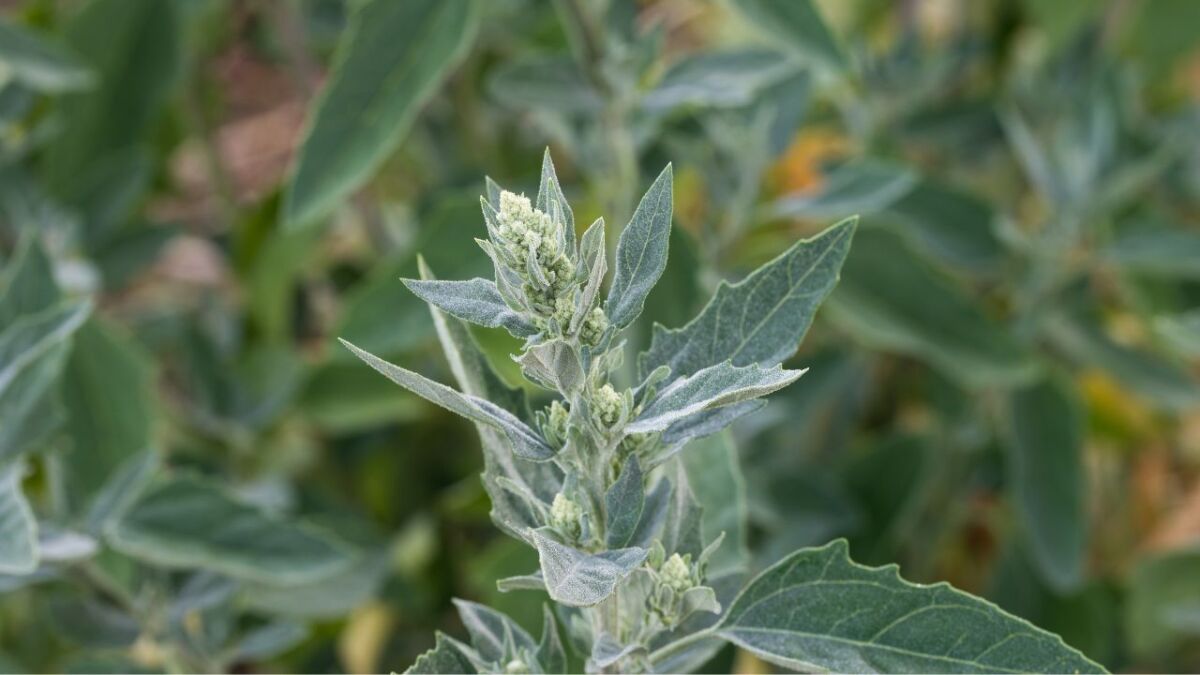
The white goose foot, an ancient and edible medicinal herb
👉 The key facts from this guide
- The white goose foot (Chenopodium album) is an ancient plant that has been used since the Stone Age.
- Today, it receives little attention despite its anti-inflammatory properties, and can be used for insect bites, sunburn, gum inflammation, and rheumatism.
- The plant contains important ingredients like iron, potassium, calcium, phosphorus, magnesium, zinc, vitamin A and C.
- In the kitchen, the leaves can be cooked like spinach or added to egg dishes, while the flowers can be prepared like broccoli.
- In India, the goose foot is still cultivated for its leaves and seeds and used in curries.
- The seeds of white goose foot resemble quinoa and can be eaten as grain.
The white goose foot (Chenopodium album), also known as fat-hen or lamb's quarters, reveals some of its historical uses with its name.
But let's go further back in time because the name doesn't tell us anything about the age of the plant and its versatility.
As various archaeological finds show, the plant was already cultivated and grown as a vegetable long before the Middle Ages.
Even further back, seeds of the plant have been found in caves, indicating that goose foot was used in the Stone Age.
Why goose foot gets so little attention today is probably due to its average nutritional value and the fact that there are now vegetable varieties that are much more productive.
Despite all this, there are some aspects of white goose foot that make it interesting for us and warrant a closer look.
Why is it called white goose foot?
The plant got its name "white goose foot" from the shape of its leaves, which resemble the feet of geese.
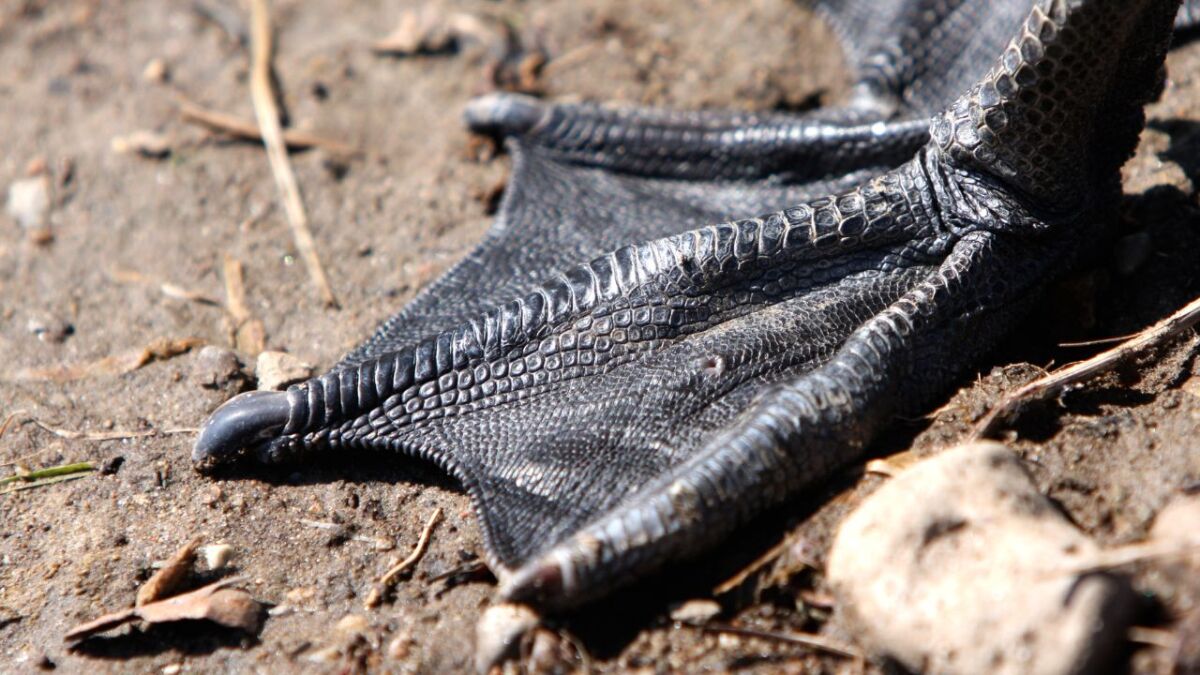
It is also said that young geese were fed with this plant in the past. The "white" part of the name refers to the white powdery coating that covers its leaves, resembling mildew.
Some varieties of the goose foot family, such as the garden orache, good King Henry, and strawberry spinach, were also cultivated as vegetables in the past and have largely disappeared from human diets.
For feeding pigs, chickens, and other livestock, it is still used in rural areas today.
The white goose foot owes another name to this circumstance. It is also called Saumelde or Mistmelde in colloquial language.
Properties and effectiveness as a medicinal herb
Actually, in folk medicine as well as in modern medicine, there is hardly any use for the goose foot.
Since there are many other medicinal plants with similar effects, about which more detailed traditions exist, the goose foot is somewhat of a stepchild among medicinal plants.
The health benefits of white goose foot are unfortunately not well documented, but there are also no indications of adverse side effects from consuming the leaves.
Yet, it is completely unjustly ignored because the goose foot has an anti-inflammatory effect and can be applied internally as well as externally.
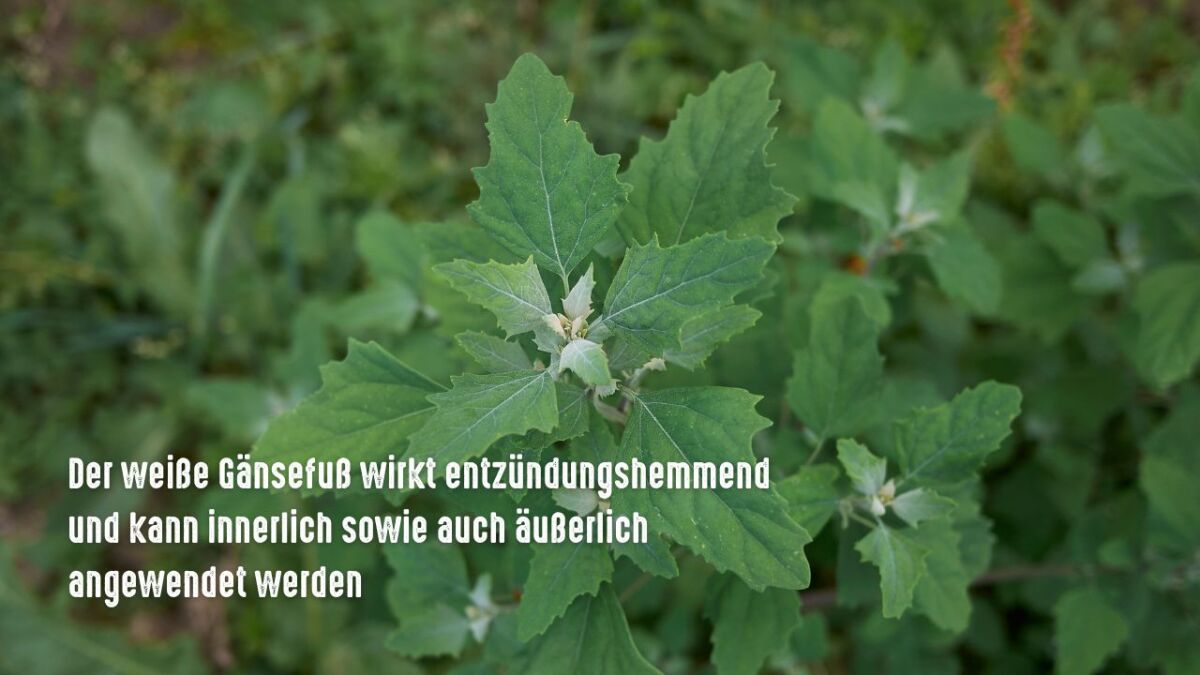
Its field of application is quite wide-ranging.
- Insect bites and sunburn can be treated with a tincture or a decoction made from the leaves.
- For gum inflammation or other throat inflammations, the plant can be used for gargling.
- For faster wound healing, the affected area can be dabbed with the juice and treated. This also applies to eczema.
- The white goose foot has already been successfully used for treating rheumatism and joint inflammations.
- When used internally, it helps with intestinal inflammation, worm infestations, constipation, and flatulence. The herbs and flowers are used in this case.
Although it contains italic acid, three cups of tea for internal use per day is harmless.
The ingredients of white goose foot, in addition to saponins, are:
- Iron
- Potassium
- Calcium
- Phosphorus
- Magnesium
- Zinc
- Vitamin A and C
There are therefore good reasons to keep the white goose foot in mind. Especially in times of emergency or crisis, it is good to know about a plant that can be used in so many ways.
Research on the current medical use of white goose foot
Research on the current medical use of white goose foot has been carried out by scientists from various parts of the world, including China, India, and Europe.
These initial studies have indicated that the plant could be used as an effective treatment for skin conditions such as eczema and psoriasis.
However, there are still many other applications for this herbaceous plant that need to be examined more closely before any conclusions can be drawn.
From the field to the kitchen
When supplies were low and food was not yet on supermarket shelves, wild vegetables were often used in the past.
In addition to wild carrots, white goose foot was also used to bring something edible to the table. The leaves were cooked like spinach, for example, or added to egg dishes.
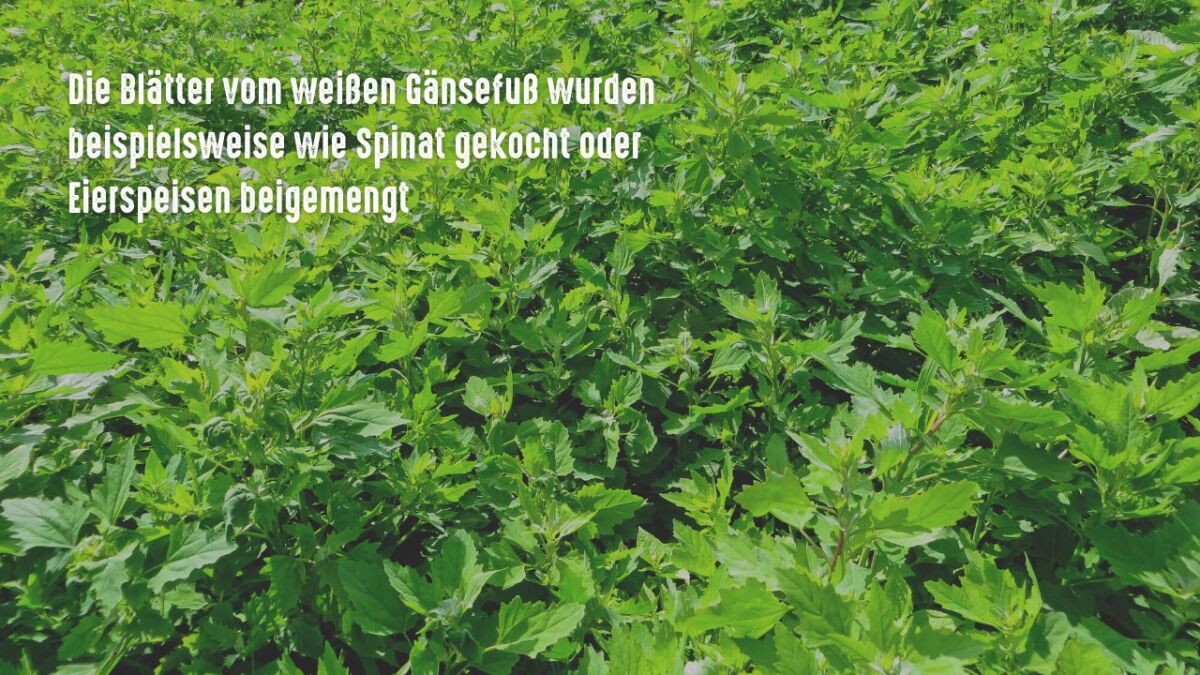
White goose foot, like other goose foot species, prefers to grow where people are. So, it is at home in cornfields, but also likes to infest construction sites or heaps.
One could almost talk of an invasion because it spreads quickly, and most people see it as a weed.
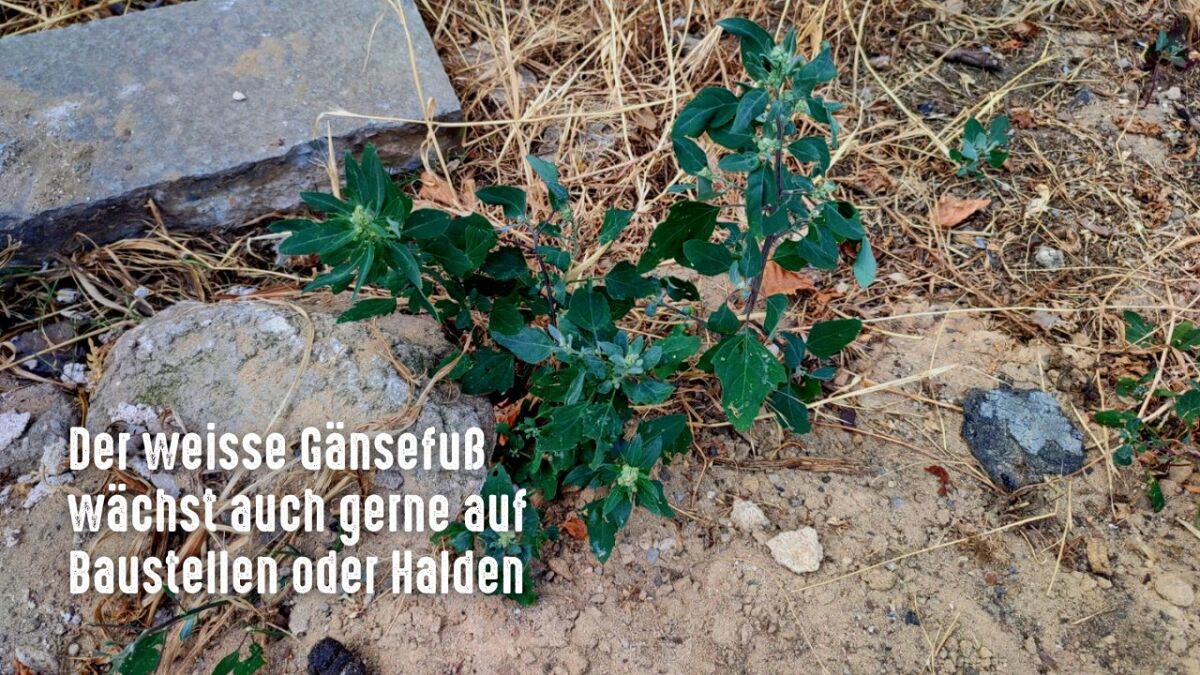
As the small seeds are carried by the wind, the plant's spread is quite rapid.
But let's get back to the kitchen and the preparation
The flowers of white goose foot are visually rather inconspicuous, but can be prepared like broccoli. To achieve this, simply pluck off the flower heads, wash them and steam them like broccoli.
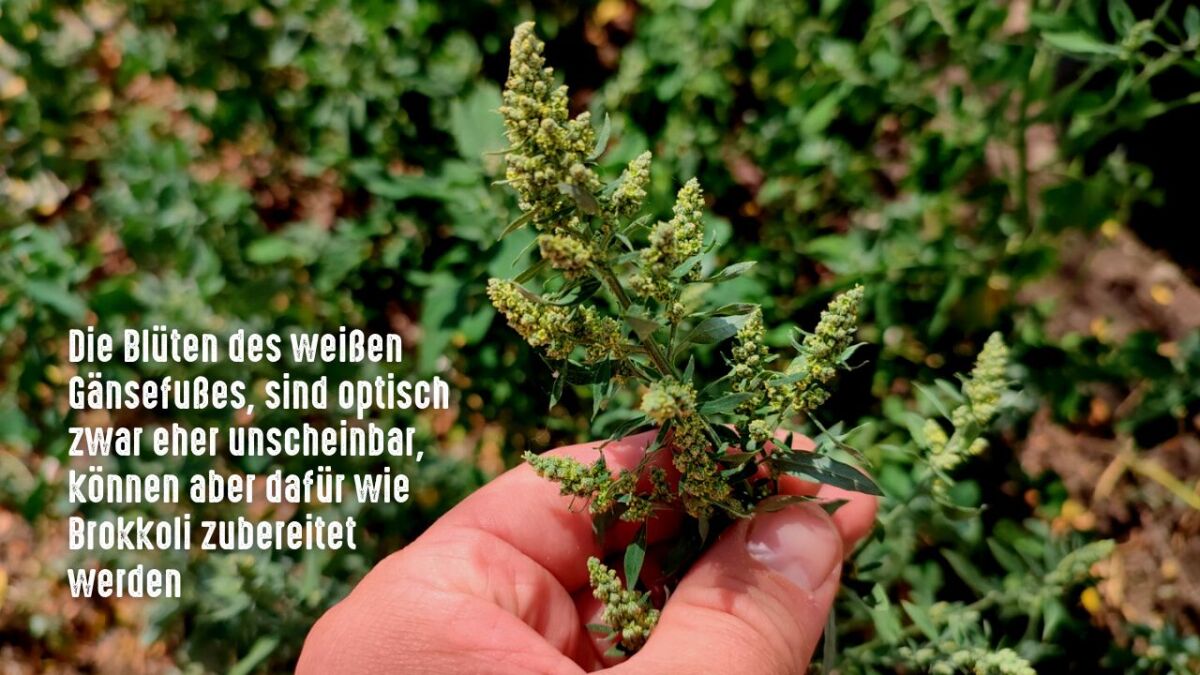
White goose foot also works great in omelets. The young leaves are chopped and simply mixed with the omelet mixture like spring onions and fried as usual.
The leaves taste very much like spinach, but with a deeper "green" flavor and many more minerals. They are best on the smallest plants, and once the heat of midsummer hits, they begin to turn bitter.
In India, goose foot (Chenopodium album) is still cultivated for its leaves and seeds. The leaves are used in curries like spinach and are called Bathuwa. The seeds are eaten as a cooked grain.
And as we already know, Asians predominantly reach a high age and suffer from obesity or overweight much less often than Europeans or Americans.
In short, the Asian region places great value on a healthy and natural cuisine.
Recipe tip: Yogurt sauce with white goose foot
In addition to the main ingredient of about 250 grams of yogurt, you need:
- 100–150 grams of white goose foot
- half a teaspoon of cumin
- a pinch of chili powder
- a quarter teaspoon of Kala Namak
- salt and vegetable oil.
The Kala Namak salt (buy here) is black and sulfuric. Therefore it smells like eggs. In combination with avocado, therefore, there is hardly any difference in taste to notice in terms of eggs. You can get it in all well-stocked supermarkets or online.
Preparation:
- To prepare the goose foot, simply pluck the leaves and wash them.
- Then boil or steam the leaves until they are soft, which happens pretty quickly.
- Once drained and slightly cooled, simply mix them into a paste with some oil.
- Now add the yogurt and mix everything together.
- Season it with the sulfur salt.
Toast the cumin seeds in a pan and then mix them with the chili powder. Then add the mixture to the yogurt.
The sauce goes well chilled with various Asian dishes, meats, or even just bread. By the way, you can also add white goose foot to bread dough. It is just as suitable for baking as it is for cooking.
Collecting Wild Quinoa with Goose foot Seeds
Every grain we know today has a wild ancestor - but some are more domesticated than others.
Quinoa (Chenopodium quinoa) is relatively new to domestication and its wild cousin (Chenopodium album, the white goose foot) is not essentially different from the modern cultivated grain.
The seeds may be a little smaller, but the plants look almost identical when they sprout in the spring.
What you may not know is that wild quinoa is probably growing in your garden. Also known as goose foot, the plant is almost as widespread as dandelions and is considered a weed by gardeners all over the world.
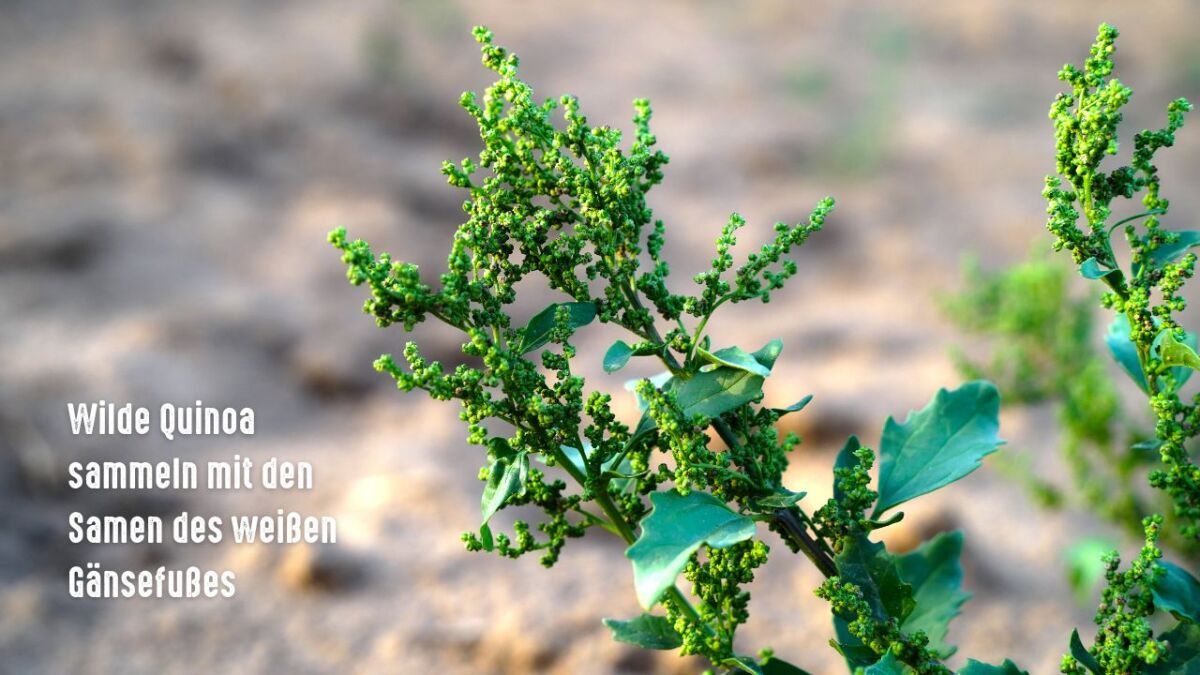
Most collectors harvest the leaves in the spring as tasty salad greens, but if you let the plant mature, it produces a wild grain harvest in the fall.
The grain has been eaten by peoples all over the world, even alongside more modern native varieties. Remains of goose foot seeds have been found at Iron Age, Viking Age, Roman sites, and more recent British archaeological sites.
Goose foot seeds were found in the stomach of the Man of Dätgen, a body preserved in a Danish bog that dates back to 300 BCE, as well as in several other preserved bog bodies throughout history.
During the summer heat, goose foot plants shoot up in height and sprout like any salad greens. They grow larger and produce tiny white seed heads at the top of leggy plants. In the autumn, they are nearly 1.5 meters tall, bushy plants that barely resemble the small salad greens of spring.
As the temperatures drop in the autumn, the seed heads will mature. Once they take on a bright magenta hue, the goose foot grain inside is ready for harvest.
How to harvest goose foot quinoa
The harvest itself is relatively simple.
- Simply grasp around each group of seeds with your palm and gently strip the seeds from the stem.
- Open your hand, and you'll find a crumbly mixture of goose foot grains and chaff. If the chaff isn't visible yet, then crush everything in your hand.
- The tiny black dots are the goose foot grain, and the green and red chaff must be separated from the finished grain.
The issue is that it's difficult to separate the chaff from the grain. While the grain can be ground into flour chaff with other wild grains like sour dock seeds, that's not a suitable solution for goose foot.
The seeds themselves make up a tiny portion of the harvest and are surprisingly bitter. The chaff is mostly indigestible and makes up the majority of the seed material.
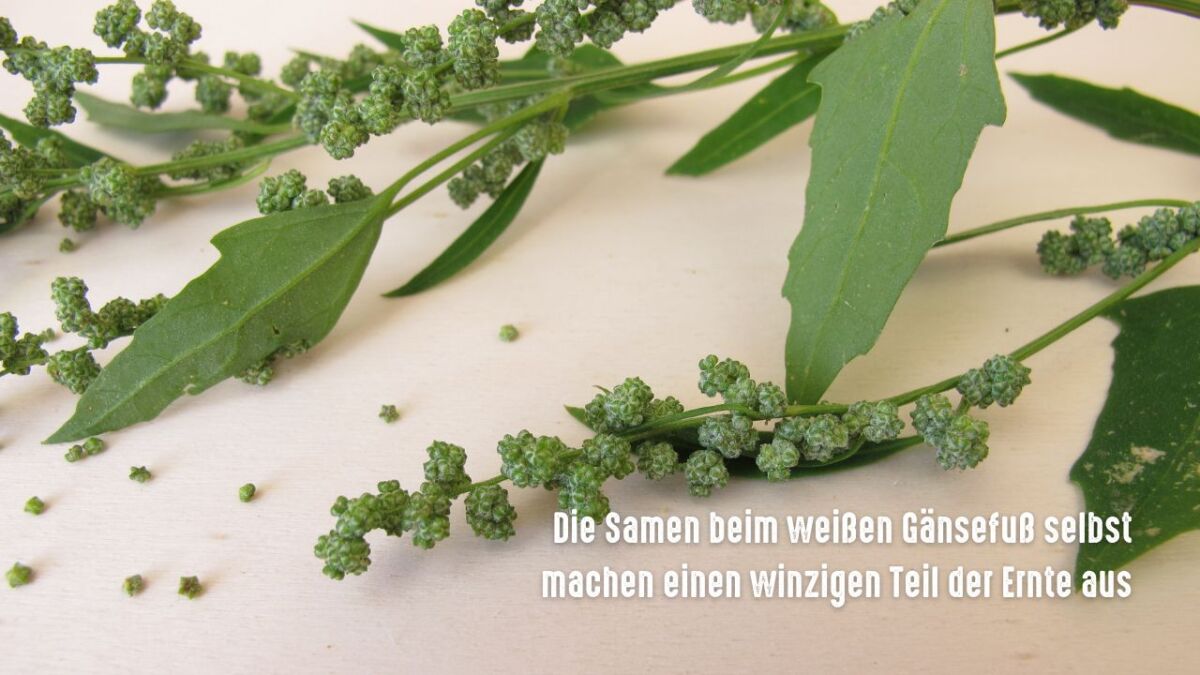
How to separate goose foot seeds from chaff
First, I placed the harvest – the goose foot seeds and the chaff – in water. It became apparent that the seeds are slightly heavier.
Using my hand, I scooped most of the chaff out of the water and subsequently poured the water gently out of the bowl. The heavier chaff is still slightly lighter than the seeds, and though it doesn’t float, it flows out in front of the grains if you pour carefully enough.
So, slowly pour the water out of a bowl and then scoop out the remaining chaff, leaving only the small black seeds.
The yield was surprisingly low, and I obtained a tablespoon of moist goose foot seeds from two cups of harvested grain and chaff.
Although the yield is low, I was able to harvest almost four cups of chaff from a large goose foot plant in about 2 minutes. Separating the seeds took no longer than 3 minutes.
Assuming you have enough water and good containers for separating, that's 1.5 cups (0.35 l) of finished grain per hour of work.
It's challenging to say whether goose foot seeds are as nutrient-rich as quinoa. I boiled the seeds in water for about half an hour, and they puffed up in the same way quinoa does. Instead of being soft, though, they're much smaller and crunchier.
Given the abundance of goose foot plants, though, it's useful to know about goose foot grain for a survival situation.
Assuming you have enough water to process grain from chaff, you could sustain yourself with a little work until you come across better options.
Identifying Goose foot
Lastly, let's discuss the appearance and preferred location of the plant.
You have probably seen it before, as it grows wherever the soil allows. Many gardeners can hardly put their "luck" into words.
Unfortunately, since far too few people still bother to familiarize themselves with old medicinal and vegetable plants, goose foot is generally considered a weed.
You can identify the plant by the following characteristics:
The plant's height can vary between about 50 centimeters and around 2 meters, depending on the location. However, it usually only reaches an average height of around 70 centimeters.
Its stem has rounded edges that are widely branched. Be sure to use young plants, as the older ones tend to become woody.
The leaves are attached to small stems and grow at irregular, alternating intervals. They have an oval to lanceolate growth form that tapers to a point at the end, and their edges are lightly, but also irregularly, serrated.
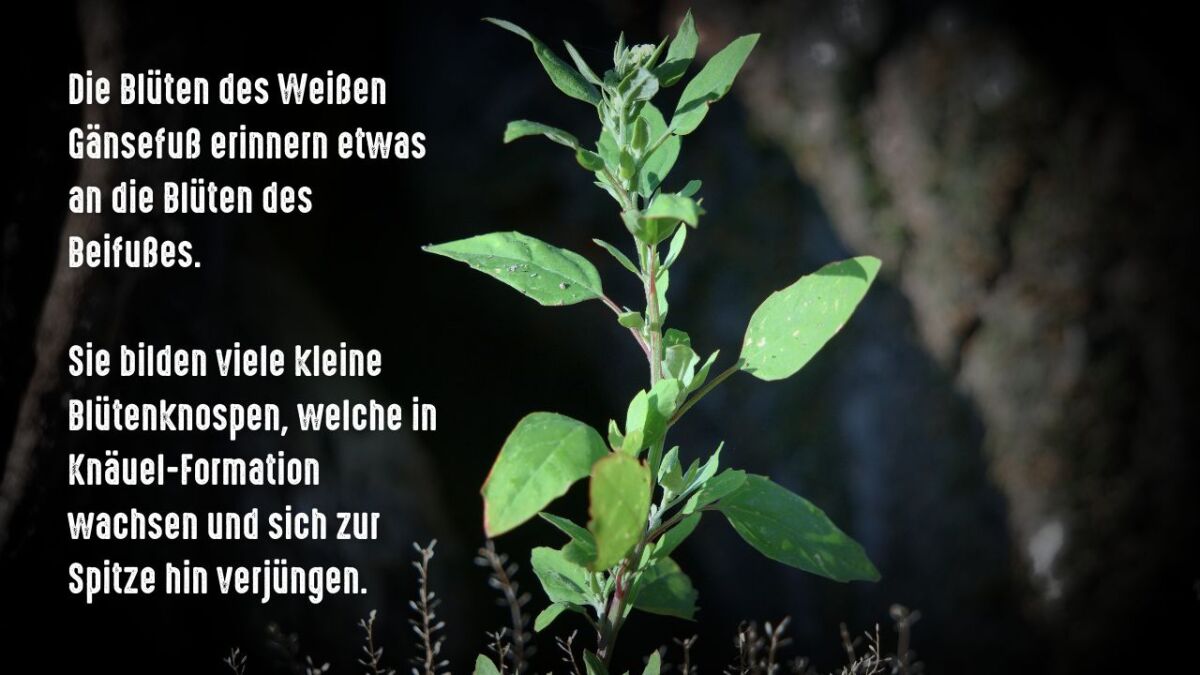
The flowers are somewhat reminiscent of mugwort flowers. They form many small flower buds that grow in a cluster formation and taper toward the top.
The white, powdery appearance of the plant comes from the tiny hairs on the stem and flower heads, giving the plant its characteristic name.
Conclusion about Goose foot: long forgotten, but useful and healthy
When wild food stands by the wayside, it's correct to ask why more people don't rely on it.
The knowledge of the treasures of nature should not be lost, so that future generations too can benefit from it.
Following the example of the white goose foot, we can learn more about our domestic wild herbs from foreign cultures than is passed on here.
This is a circumstance that should make us all think and, above all, rethink.
And knowing which emergency food is available in the forest or which edible things can be found in winter can save your life in survival situations.


Author of the guide
Martin Gebhardt
Hey, I'm Martin. On my blog, you will learn the basics and numerous details about living in the wild. I think survival, bushcraft and the good life in nature are the keys to happiness. Find me here on Instagram or on YouTube. You can find more about my mission on the About Me page.
Was this guide helpful?
28 people found this guide helpful.
5.00 out of 5 points (28 Ratings)
Comments (0)
This post may contain affiliate links. So if you click on the links and make a purchase, I will receive a small commission at no additional cost to you. Click here, to learn more about it.


